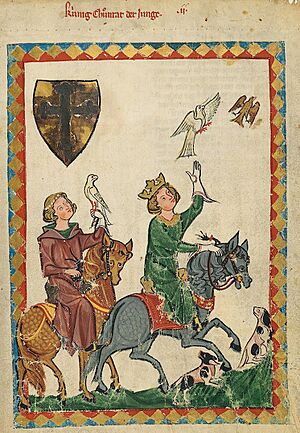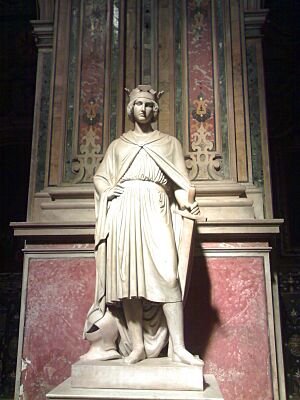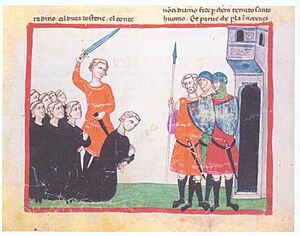Conradin facts for kids
Quick facts for kids Conradin |
|
|---|---|

|
|
| King of Jerusalem | |
| Reign | 21 May 1254 – 29 October 1268 |
| Predecessor | Conrad II |
| Successor | Hugh I |
| King of Sicily | |
| Reign | 21 May 1254 – 1258 |
| Predecessor | Conrad I |
| Successor | Manfred of Sicily |
| Duke of Swabia | |
| Reign | 21 May 1254 – 29 October 1268 |
| Predecessor | Conrad III |
| Successor | Rudolph II of Austria (titular) |
| Born | 25 March 1252 Wolfstein Castle near Landshut, Bavaria, Holy Roman Empire |
| Died | 29 October 1268 (aged 16) Naples, Kingdom of Sicily |
| Burial | Basilica di Santa Maria del Carmine, Naples |
| House | Hohenstaufen |
| Father | Conrad IV of Germany |
| Mother | Elisabeth of Bavaria |
Conradin (born March 25, 1252 – died October 29, 1268) was a young prince, also known as Conrad III. He was the last direct heir of a powerful family called the House of Hohenstaufen. He held important titles like Duke of Swabia, King of Jerusalem, and King of Sicily.
Conradin tried to win back the Kingdom of Sicily for his family. Sadly, his attempt failed. He was captured and then executed.
Contents
Conradin's Early Life and Family
Conradin was born in Wolfstein, Bavaria. His parents were Conrad IV of Germany and Elisabeth of Bavaria. His father died in 1254, when Conradin was very young.
Even though he never became the Roman-German king, many people recognized him as the king of Sicily and Jerusalem. This happened in 1254.
Conradin grew up at the court of his uncle, Louis II, Duke of Bavaria. Louis was his guardian. His guardians helped him keep control of Swabia, which was his duchy.
In Jerusalem, a relative from the royal family of Cyprus ruled as a regent. A regent is someone who governs a kingdom when the king is too young or unable to rule.
In Sicily, his father's half-brother, Manfred, was also a regent. But Manfred started planning to take the kingship for himself.
Not much is known about how Conradin looked or what his personality was like. People said he was "beautiful as Absalom" and spoke good Latin.
The Church was supposed to protect Conradin. However, Pope Alexander IV did not want Conradin to become the Roman-German king. The Pope even offered Conradin's lands in Germany to King Alfonso X of Castile.
Conradin's Fight for Power
Conradin officially took the titles of King of Jerusalem and King of Sicily. In 1262, he took control of the Duchy of Swabia. He stayed there for some time.
His first chance to go to Italy came from the Guelphs in Florence. The Guelphs were a political group who supported the Pope. They asked Conradin to fight against Manfred. Manfred had been crowned king of Sicily in 1258. This happened because of a false rumor that Conradin had died.
Conradin's uncle, Louis, refused this invitation for his nephew.
The Call to Italy
In 1266, Charles I of Anjou defeated and killed Manfred. Charles was called by the new pope, Clement IV. Charles then took control of southern Italy.
After this, messengers from the Ghibelline cities came to Bavaria. The Ghibellines were another political group, who supported the Holy Roman Emperor. They urged Conradin to come to Italy and free it from Charles.
Count Guido de Montefeltro and Henry of Castile, a senator from Rome, promised Conradin the support of Rome. Conradin then promised his lands to get money for his journey. He crossed the Alps mountains. In Verona, he announced his claim to Sicily.
Conradin's Campaign
Even though his uncle Louis and other friends went back to Germany, Conradin's cause seemed to be doing well. Clement IV also threatened him. Conradin also had little money.
Still, his supporters, including Prince Henry of Castile, took up arms in both northern and southern Italy. They declared him King of Sicily. Rome welcomed his messenger with excitement. The young king himself was welcomed in Pavia, Pisa, and Siena.
In September 1267, a Spanish fleet arrived in the Sicilian city of Sciacca. Many knights from Pisa and Spain also came. Most of the island of Sicily rebelled against Charles's rule. Only Palermo and Messina stayed loyal to Charles. The revolt spread to Calabria and Apulia.
In November of that year, the Pope officially removed Conradin from the Church. This is called excommunication.
Conradin's fleet won a battle against Charles's fleet. In July 1268, Conradin himself entered Rome. He received a great welcome from the people.
The Battle of Tagliacozzo
Conradin made his army stronger. He marched towards Lucera to meet up with Saracen troops. These troops had been living there since his grandfather's time.
On August 23, 1268, Conradin's army met Charles's army. This happened at Tagliacozzo, in a hilly part of central Italy. Conradin's army was made up of soldiers from Italy, Spain, Rome, Arabia, and Germany.
At first, Conradin's forces seemed to win. The Spanish knights, led by Prince Henry of Castile, charged forward and captured Charles's flag. But Charles used a clever trick. He had hidden some of his best French knights behind a hill. When these knights entered the battle, Conradin's army was surprised. Charles's army then won the battle.
Conradin escaped the battlefield and reached Rome. But he was advised to leave the city. He went to Torre Astura to try and sail to Sicily. However, when he arrived, he was arrested. He was handed over to Charles. Charles imprisoned him in the Castel dell'Ovo in Naples, along with his friend Frederick of Baden.
On October 29, 1268, Conradin and Frederick were executed.
Conradin's Legacy

Conradin was only 16 when he died. With his death, the direct male line of the Hohenstaufen dynasty ended. His remains, along with Frederick of Baden's, are in the church of Our Lady of Mt. Carmel in Naples. His mother founded this church for his soul.
In 1847, Maximilian, who was the crown prince of Bavaria, put up a marble statue in Conradin's memory. This statue was made by Bertel Thorvaldsen.
In the 14th-century Codex Manesse, there are two songs written by Conradin. This book is a collection of medieval German poems. Conradin's story has also been the subject of several plays.
Succession After Conradin
Conradin's Kingdom of Jerusalem passed to the heirs of his great-great-grandmother, Isabella I of Jerusalem. There was a disagreement over who should rule next.
- The main heir was Hugh of Brienne.
- But another cousin, Hugh III of Cyprus, was already ruling as regent. He managed to keep the kingdom as Hugh I of Jerusalem.
- Conradin's grandmother's cousin, Mary of Antioch, also claimed the throne. She later sold her claim to Charles of Anjou, who had executed Conradin.
The general heir to his Kingdom of Sicily and the Duchy of Swabia was his aunt Margaret. She was his father's half-sister. Her son, Frederick, claimed Sicily and Swabia through her.
However, these claims did not gain much support. Swabia was falling apart as a territory. Conradin was not recognized in the Crusader states. Charles of Anjou was firmly in power in Southern Italy. Margrave Frederick planned to invade Italy in 1269, but his plans were never carried out.
Finally, Sicily went to Charles of Anjou. But in 1282, an event called the Sicilian Vespers led to two different claims on the Kingdom. The Aragonese heirs of Manfred kept the island of Sicily. Charles's family, the Angevins, kept the southern part of Italy, which became known as the Kingdom of Naples.
Conradin in Literature
Conradin's story was popular in art and literature in the 1800s and early 1900s. Many paintings and poems showed his military campaign and his execution.
- Felicia Hemans, famous for "The boy stood on the burning deck," wrote "The Death of Conradin" in 1824.
- Charles Swain wrote "Conradin" in 1832. This poem inspired music by Justin Henry Rubin.
- Conradin : a philosophical ballad was written by C. R. Ashbee in 1908.
The novel Põlev lipp (The Burning Banner) by Karl Ristikivi (1961) tells the story of Conradin's Italian campaign. It was translated into French in 2005.
See also
 In Spanish: Conradino de Hohenstaufen para niños
In Spanish: Conradino de Hohenstaufen para niños


